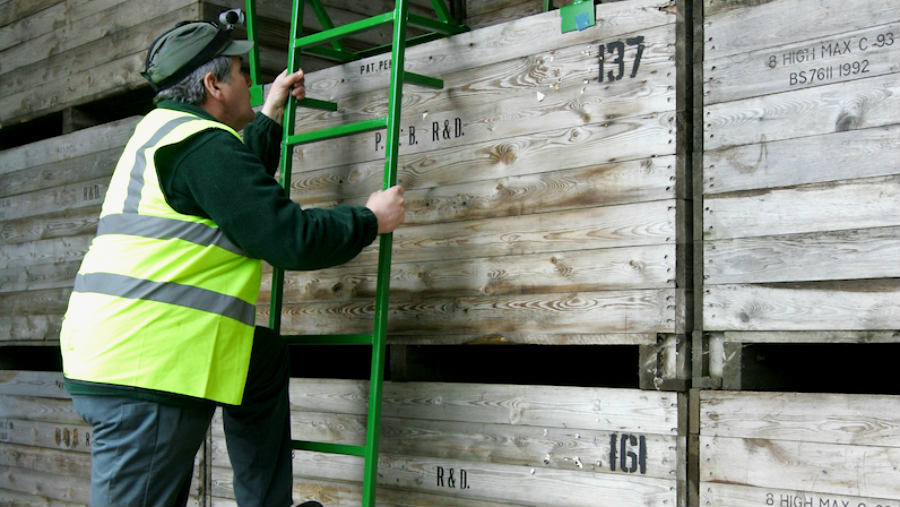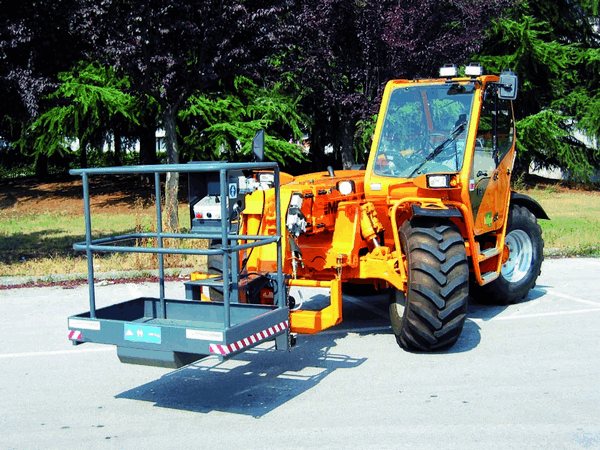Farm health and safety: Working at height
 © Tim Scrivener
© Tim Scrivener Falls from height are the biggest workplace killers and one of the biggest causes of major injury, and agricultural work carries an above-average risk of falling accidents.
Statistics from the Health and Safety Executive (HSE) in 2020 put falls from height as the second cause of death and third cause of serious accidents in agriculture.
You don’t have to be very high to suffer a serious fall. Recent case histories include at least one fatality and numerous injuries due to falls from 2m or less. Falling from ground level into a hole can also cause serious injury.
See also: Working at height: All you need to know about man-cages
Why agriculture has a poor falls record
- Farming often involves people working on their own, and this is one of the reasons for the relatively high risk of accidental falls in agriculture.
- Not only does working alone increase the risk of an accident but it also means that if someone is seriously injured there is nobody to call for help. If neighbouring farmers agreed to help each other with jobs that carry a particular risk of accidents, some injuries could be avoided and it would probably get jobs done more quickly.
- Another problem is the financial pressure many farmers have faced. This increases the likelihood of choosing the do-it-yourself approach instead of paying a specialist contractor to do the work.
Making the job safer
Planning
Planning, including a risk assessment, should be an essential part of the preparation for jobs that involve working at height, and this has high priority in the Work at Height regulations.
They apply to employees, employers and the self-employed and specify that anyone doing jobs involving the risk of a fall must be competent to do that kind of work and must use suitable equipment that is properly maintained and inspected.
Measures are also needed to avoid injuries by objects falling from where someone is working. Areas where this may be a risk must be clearly identified and have restricted access.
Falling from farm vehicles
There are three key areas where most fall incidents happen:
- Carrying passengers in unsafe positions. Only carry someone else (over the age of 13) if a proper passenger seat is fitted and never on drawbars or loaded trailers.
- Falls from vehicles during loading/unloading or maintenance. Plan work to avoid climbing on to trailers if possible but, if it is necessary, make sure you keep the work area clear of trip hazards and take extra care.
If you need to work at height, for example to clean a combine or change cab filters, use suitable access equipment.

Accidents when loading and unloading are common
Slips/trips mounting tractors or mobile machines – always use the steps and handholds provided and face inwards so that you can maintain a good grip. Keep cab steps well maintained and never jump down from a tractor cab or machine – you don’t have to fall far to fall hard!
Ladders
Jobs that involve climbing a ladder or working on a roof are at the top of the danger list. Before using a ladder always question whether safer access equipment could not be used instead.
If climbing a ladder is the best option the risk assessment should include checking that it is in good condition and that there is a firm, level base to support it. In some situations it is possible to secure the ladder by roping it to a suitable support.
Ladders are acceptable for jobs that can be done quickly and with a low level of risk, but the risks increase significantly when using a ladder for long periods, moving it frequently or climbing repeatedly to carry tools or work materials.
The alternatives to using a ladder for more hazardous projects include a suitable work platform or basket on a telehandler boom. For planned or regular work at height only fully integrated and properly constructed working platforms should be used.
Another option is to hire a self-propelled scissor-lift platform providing enough lift height for most on-farm building maintenance jobs. Operator training is required for using both a telehandler work platform and the scissor-lift type.
Roofs
Working on roofs involves several different falling risks. They include a fall climbing to or from the roof, falling through a roof light, treading on a weak part of the roof and falling off the edge.
Other roofing hazards include strong winds and other adverse weather conditions, which should always be avoided.
The risk of serious injury is increased because there is usually a solid floor below, and there are also special problems on buildings with sloping or curved roofs.
The initial assessment should include investigating whether the work could be done from the underside of the roof instead of the top, but if working on the roof is unavoidable, choose the safest option for gaining access and for lifting the work materials.
Evidence from case histories shows that some roof falls result from inadequate support platforms.
Each platform section should be at least 60cm wide and long enough to span at least three purlins, and there should be enough platform sections to provide a continuous walkway – gaps between sections are dangerous.
Bales stacked almost to roof height under the work area reduce the risk of injuries if there is a fall, while a sturdy barrier at least 910mm high will reduce the risk of falling over the edge.
Contractors
Using a competent contractor may be cheaper in terms of human and financial cost than the time lost due to an accident.
Even when a specialist contractor is called in to do risky jobs such as roof repairs, the farmer still has safety obligations.
These include drawing the contractor’s attention to any factors that could affect safety, such as tractor and other vehicle movements near the work area and the location of overhead wires.
Complying with the regulations will mean more time needed for planning and preparing many jobs on the farm, and special access equipment costs more to buy or hire than using a ladder. This could make ignoring the regulations seem a tempting option – at least until things go wrong.
Unfortunately serious accidents caused by falls happen on hundreds of farms each year and even the non-fatal falls can be disastrous – a broken leg may cause chaos if it stops someone doing the milking or driving a tractor for a few weeks.
A hired self-propelled platform provides enough height for most on-farm building maintenance jobs.
The alternatives to using a ladder for more hazardous projects include a suitable work platform or basket on a telehandler boom.
If you are considering a new farm building, there is one very important point to bear in mind which, if ignored, could land you in deep trouble.
The Construction Design and Management Regulations 2007 (CDM) state that when you employ a contactor, you must ensure that they are competent in Health and Safety.
If there is an accident and you cannot prove that you have done so, you could be open to prosecution by the Health and Safety Executive.
Furthermore, if you start to specify certain aspects of the building, such as its layout, placement, or type of cladding, you would be considered a designer, and if you use more than one contractor, you could be considered the principal contractor – each bringing more responsibility, and therefore more risk.
Unfortunately there are no hard and fast rules which you can use to ensure that your contractor is competent.
Personal recommendation, history and reputation are good starting points. It would also be wise to see and keep copies of relevant documentation such as a company’s health and safety policy.
A certain peace of mind may also come by choosing a contractor who is a member of the Rural & Industrial Design & Building Association (RIDBA) as members must adhere to a strict code of practice which includes complying with all current Health and Safety Legislation and the RIDBA complaints procedure.
Further information
See the Health and Safety Executive website for further advice and regulation on working from height
For a list of RIDBA members and details see the RIDB website
